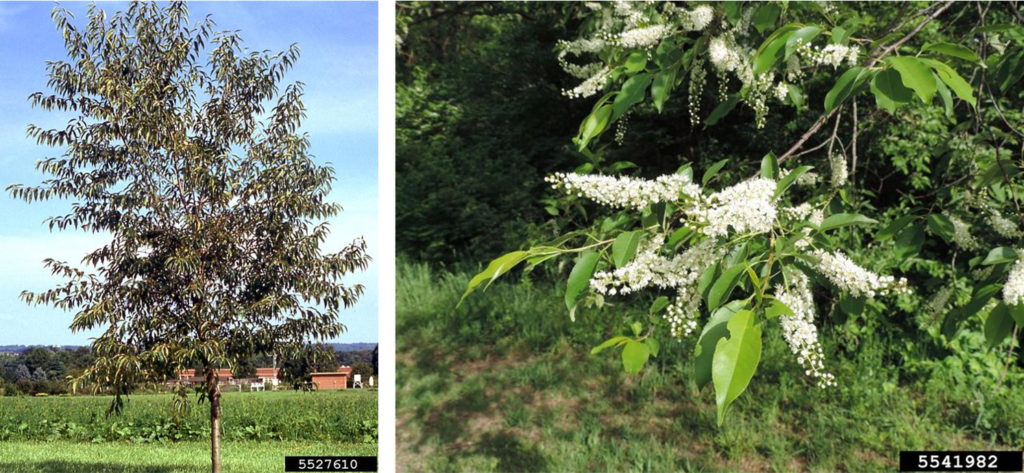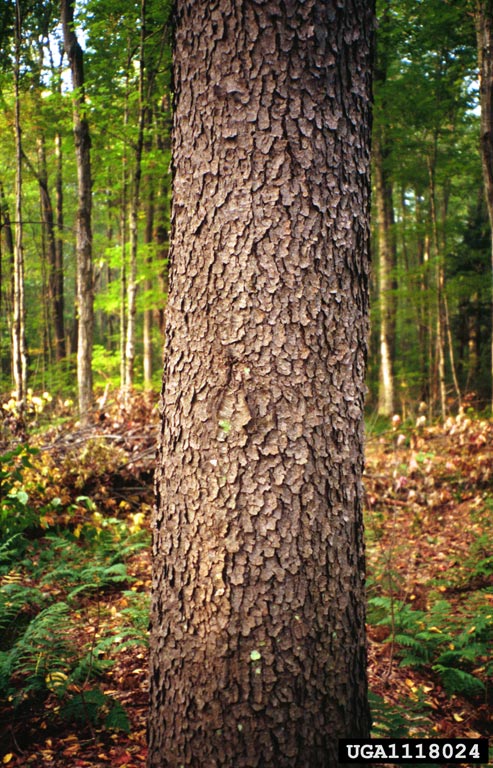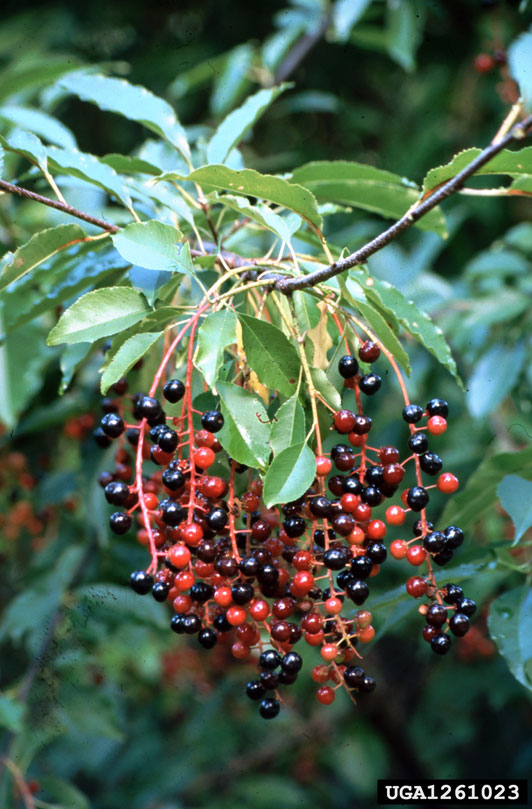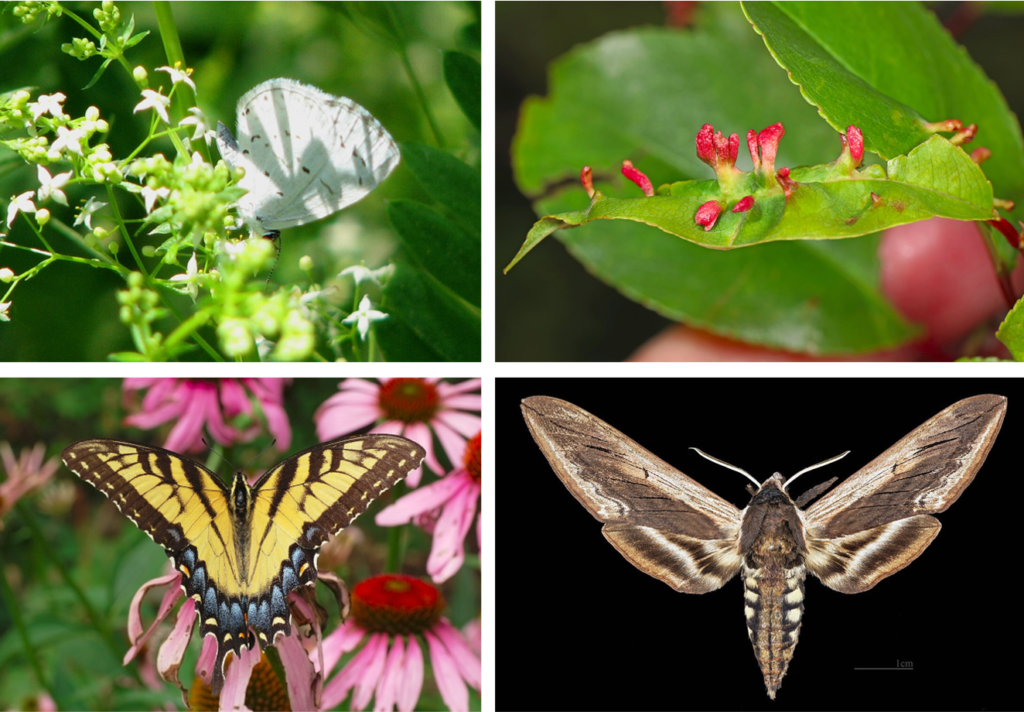
At a glance:
- Soil needs: In the eastern USA, prefers neutral to acidic soils. Accepts many soil types as long as it is well-drained.
- Water needs: Medium water needs, about 1 inch per week.
- Sun needs: Partial shade to full sun. Ideally at least 6 hours of sunlight per day. Can tolerate shade too, but growth and fruiting will be reduced.
- Size needs: Medium. At full size, up to 60-90 feet tall, with a spread of 35-50 feet.
- Growth rate: Fast, about 1 to 4 feet per year.
- Tolerates Black Walnut: Yes, this tree can be planted near Black Walnut.
- Wildlife value: Extremely high, almost none better. Hosts over 450 species of butterflies and moths. Fruit are consumed by at least 33 species of birds, and many mammals as well. Will bring high levels of diversity to any yard.
A bit more…
Black cherry, or Prunus serotina, is a delightful tree with extremely high ecological value. Luckily, it is fairly common. It is a pioneer species, meaning it is often one of the first trees to colonize disturbed sites like roadsides and old fields. But if there isn’t already one on your property, it is certainly a worthy addition… for the wealth of nature it will bring, but also for its own beauty, too! These trees can form a very handsome shape, and their flowers are quite conspicuous and lovely.

Of course, the shape pictured above occurs when there’s a bit of space between the tree and its neighbors. Black cherry trees can also survive in shade, but the result is that they become tall and slender, competing for light and room in the canopy. This is how they are on my property. It actually took me a while to realize that there are three on my lot. The flowers are high and out of view, and the fruit is eagerly snatched up by birds and squirrels. What really made me start noticing the trees was when I became able to identify its bark. It is a beautiful, highly-textured, flaky bark that is quite striking. Once you are able to pick it out of a crowd, you will start to notice this tree a lot more often!

Speaking of its bark, black cherry bark has been used for centuries in traditional/herbal medicine to make a potent cough syrup. However, trying to do this yourself is NOT ADVISED, as the bark is highly toxic. In fact all parts of the plant, except for the fruit, are highly toxic. Not just to humans, but to other mammals too. Large livestock can even be poisoned by eating the leaves. Of course, many people report that deer seem to eat the leaves just fine. Some websites categorize the tree as deer resistant, while others do not. My trees are all taller than the deer can reach, so I have no personal experience, but it seems to me that any tree which is not unanimously agreed upon as being deer resistant, is not deer resistant.

Do not let the word of warning regarding leaf and bark toxicity dissuade you from the tree’s perfectly edible fruit. Black cherries are a tasty treat! However, you will have to compete with dozens of other animals that agree. But that’s half the fun! Don’t expect the fruits to be picture-perfect like the cherries you buy in the store, though. Like so many other wild-type fruits that have not been selectively bred for idealized traits, the flesh-to-seed ratio may not quite be what you’re used to. Because of this, many people do not find them worth it for finger-food snacking, but consider them great for making jam or wine. That sounds delicious to me, but I have never been able to harvest enough for that! The critters always seem to get them first.

But the critters truly are the reason you want this tree in your yard, anyways. This tree has one of the highest ecological values around. It supports over 450 species of moths and butterflies… and that’s only one order of insects! Some of them are pretty cool, too. It is a larval host for the eastern tiger swallowtail (Papilio glaucus), a striking butterfly that is a common favorite. It is also host to some of the largest moths around — sphinx moths. One even prefers this tree so much that it took its name: the wild cherry sphinx moth (Sphinx drupiferarum). Perhaps the coolest, in my opinion, is a butterfly whose larva eats specifically the leaf galls created by a specialist mite which only makes galls on black cherry leaves. An endemic food web right there on this tree! The butterfly is the cherry gall azure (Celastrina serotina), and the mite is the black cherry leaf gall mite (Eriophyes cerasicrumena). Not to mention dozens upon dozens of birds and mammals that also eat the cherries directly. However, the number of insects it supports really is what is most important, as all birds — even the fruit eaters — feed on bugs when they are rearing their young.
